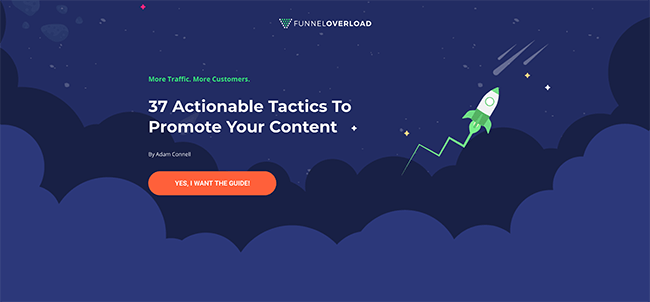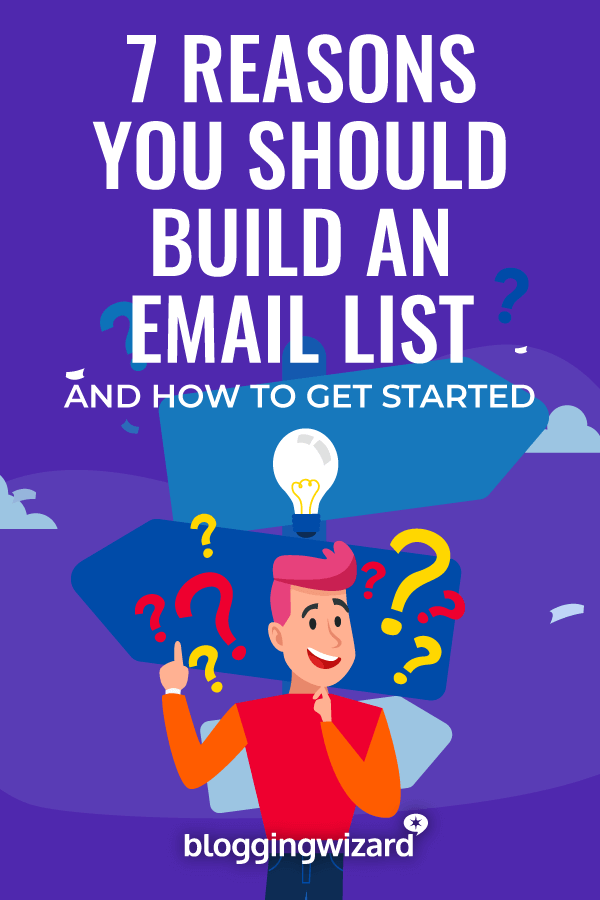7 Reasons You Should Build An Email List For Your Blog (And How To Get Started)

For some people, email might seem too old school for modern life. With so many other forms of messaging available at our fingertips, why bother with the tired, old email format?
Yet, for bloggers, email is still one of the most powerful forms of communicating with your readers. And, it can yield dramatic results for those looking to gain more leads and earn more revenue as a result.
What is an email list?
But first, what is an email list?
As a blogger, your email list is a collection of email addresses from people who have:
- Subscribed for updates from your blog
- ‘Opted-in’ to receive a free product or specific series of emails
- Purchased something from you and opted-in for further updates
Whatever the reason, these people have given you permission to keep their email on a list for future contact.
7 reasons why building an email list is important
After establishing what an email list is, it’s time to learn why it’s so valuable.
Even though email is an age-old tool, its benefits are numerous. Besides the fact that even your grandma can manage to send an email, it can also improve return on investment (ROI), audience communication and click-throughs.
Here are 7 key benefits described in greater depth.
1. Email marketing has a higher ROI than any other marketing channel
It’s tempting to reach for Twitter, Facebook and Instagram when looking for a good return on investment. They’re popular channels with easy access to your target market.
Yet, the truth remains that email marketing still offers the highest ROI of them all. It’s roughly twice as good as other forms of digital marketing. And traditional media? Well, there’s no comparison really.
According to a survey by Litmus completed by 372 marketers worldwide, the ROI of email marketing is on average, 38:1.
What this means is, email is by no means dead. It’s one of the best tools in your marketing arsenal.
2. You’re 6x more likely to get a click-through from an email than from a tweet
Consider how much time you spend marketing your blog. How much of that time is spent on social media versus email? I bet the former is greater than the latter.
Social media statistics are easy to find. Yet email marketing statistics are somewhat more difficult to find.
For example, there are far more email accounts than there are social accounts online. That is 3x more email account holders than Twitter and Facebook combined.
And when it comes to click-through rates, it’s roughly 3% for email, while on Twitter it’s around 0.5%. That’s 6x more click-throughs on email compared to Tweets.
With stats like that, it’s easy to see where you should be spending more time and attention.
3. Your email subscribers are more likely to share your content
Growing a blog is all about creating great relationships with your readers. They’re the ones who will be helping you spread the word about your content.
Communicating to your audience through your email list is a personal experience that nurtures those relationships. When your email lands in a subscriber’s inbox, you’re talking to them one-on-one, not to the masses on social media. This makes them feel important and like a valued member of your community.
What’s more, the more connected your subscribers feel, the more likely they are to share your content. There’s a sense of loyalty and trust built through email marketing that makes people far more likely to share your content on the social web.
4. Your list is built with purpose
When a blog reader wants to get updates from you, they fill in the sign-up form and confirm their email address, which in turn, provides permission for you to contact them.
The people who do this are taking the time and effort to opt-in because they absolutely want to hear from you. This makes them much more likely to take note of your emails with greater interest. They’re more receptive to your messages and primed to take action.
5. Email is highly targeted
With people already showing purpose through the act of signing up to your email list, it makes it easier to target the right people for offers and products. You already know what they’re interested in (your blog niche).
This is where email segmentation comes into its own. Segmenting your email list is about grouping your subscribers so you can better personalise your emails to them.
By segmenting your list into further interest groups, you can create highly targeted email campaigns that drive more clicks and better results.
6. You’re building a lifelong business asset
It may not seem too important on the surface, but with your email list, you’re building something that will be valuable far into the future. Social Media is fleeting and changeable while email marketing remains steadfast.
Think of it like this. Building a social media following is a bit like building a house on rented land. The ground is unstable and can be taken away at a moments notice.
As an example, just look at the decline of Facebook’s organic reach and the demise of Google+.
But with email marketing, your house is being built on land you own. It’s a stable asset that you have control over for life.
7. There are over 5.6 billion email accounts worldwide
Did you know that the use of email hasn’t slowed (as many once predicted)? In fact, the use of email has increased dramatically over the years as the internet has grown and matured.
In 2007, only 57% of the UK population used email. Compare that to 2018 roughly 84% utilised email in their daily lives.
To date, there are over 5.6 billion email account holders across the globe. That translates to 5.6 billion potential blog subscribers and customers. Even when being realistic, that’s still a huge chunk of email users compared to other marketing channels.
What you need to build an email list
Now you know how important it is to build an email list and why ignoring this area of marketing your blog is a massive mistake. The benefits far outweigh those of social media and there’s a massive audience for you to tap into.
But what do you need to get started with building your email list?
It’s pretty simple and boils down to these three things:
- A blog or website (which if you’re reading this, you have or are in the process of building)
- An email marketing service (to deliver your emails and collect email addresses)
- Opt-in forms that convert (where people will sign up or ‘opt-in’ to your list)
Let’s take a look at these in greater detail, so you know exactly what you’re doing.
Choosing an email marketing service
There are plenty of options when it comes to choosing an email marketing service.
When figuring out which email marketing service to use, research well and find one that offers you the best features and a price that suits your personal needs.
At Blogging Wizard, we’re big fans of ConvertKit but there are plenty of other great tools that may be a better fit for your needs.
Be sure to check out our article on email marketing services for help choosing.
How to get more subscribers and grow your email list
There are countless ways to build your email list, but when you’re just getting started as a blogger, you’ll want to follow these 3 steps:
1. Offer an incentive for your list (aka lead magnet)
People don’t usually sign up for email lists for no reason. Usually, there’s a carrot on the end of a stick, incentivising them for taking the time to sign up. It’s quid pro quo.
Incentives are often referred to as lead magnets – a magnet that draws the reader into taking action and they work amazingly well.
To accelerate the growth of your list, your lead magnet should be:
- Goal-driven (where does it sit in your sales funnel? What’s the next logical step after?)
- Solution-focused (does it solve a problem for your readers?)
- Useful (if it’s not useful it’s not worth subscribing)
What type of content should you build for your lead magnet? Here are some ideas that might work for you:
- Checklists
- eBooks
- Tutorials
- Videos
- Templates
- Resource Lists
- Workbooks
- E-Courses
- Cheatsheets
- Swipe files
- Scripts
- Toolkits
- Planners
- Calendars
- Etc.
To learn more about making lead magnets work for you, check out the ideas in this article.
2. Add conversion-focused opt-in forms to your blog
The average internet user spends a few seconds looking at your website. That’s a short window of time to capture their attention and encourage them to convert into subscribers. The best way to make use of that small amount of time is to use opt-in forms focused on conversions.
Conversion focused forms make the most of different features and elements to get the most opt-ins. This can include:
- Placing forms in strategic places, such as above the fold on your blog
- Using multiple form types like sidebar widgets, header banners and after content forms
- Catching people when they’re just about to leave with exit-intent forms
- Using bold colours to draw attention
- Using fonts that make an impact
- Making your lead magnet a limited time offer with countdown timers on your form
When it comes to WordPress, Thrive Leads is a great option for adding opt-in forms and leveraging other conversion-focused features. That said, there are a bunch of other great options – learn more in our article on email list plugins.
3. Create a landing page to promote your lead magnet
What is a landing page exactly? In this context, we’re talking about a conversion-focused page with no distractions. It has just one goal – to encourage people to sign up for your lead magnet. (Remember lead magnets? The offering that encourages readers to sign up).
These types of pages work well because they convert better than opt-in forms simply placed on your blog.
As an example, take this landing page that Adam Connell built for his newer site, Funnel Overload (now rebranded to Startup Bonsai):

This landing page converts at 30% – before any real landing page optimization has been done.
Your landing page doesn’t have to be complex and you don’t need to reinvent the wheel. It just needs to be focused and compelling. Include a strong headline focused on the benefits of your lead magnet, and include a strong call-to-action (this will be your opt-in form + button).
So, how do you create a page like this? Firstly, you’ll need a landing page builder.
We use a SaaS tool called Leadpages at Blogging Wizard – it is a bit pricey but extremely easy to use. However, if you use WordPress, check out our comparison of landing page plugins for some cost-effective options.
It’s also worth noting that some email marketing tools such as ConvertKit also have landing page functionality built-in. While it’s not as functional as some tailor-built plugins & tools like Leadpages, you can still get a lot of mileage out of it.
Once you have your landing page, you can promote it by:
- Adding ‘calls to action’ (CTA’s) to your blog
- Linking to it in tweets and Facebook messages
- Creating unique pins to promote it on Pinterest
- Using paid traffic from platforms like Facebook (you’ll want to have a sales funnel in place to get an ROI on your ad spend though)
The result is, you’ll have a clearer, more targeted way to drive email subscribers and a further asset you can promote for even better outcomes.
Final thoughts
Regardless of the type of blog you have, if you want your readers to turn into returning visitors, you need to build an email list.
Email subscribers have far more value than the typical social media user and with the loyalty that comes from personally tailored emails, so too do the shares, click-throughs and sales.
Not only is email at the pinnacle of successful modern marketing channels, but it’s also easy to use and has endless potential for your blog.
Further reading:

